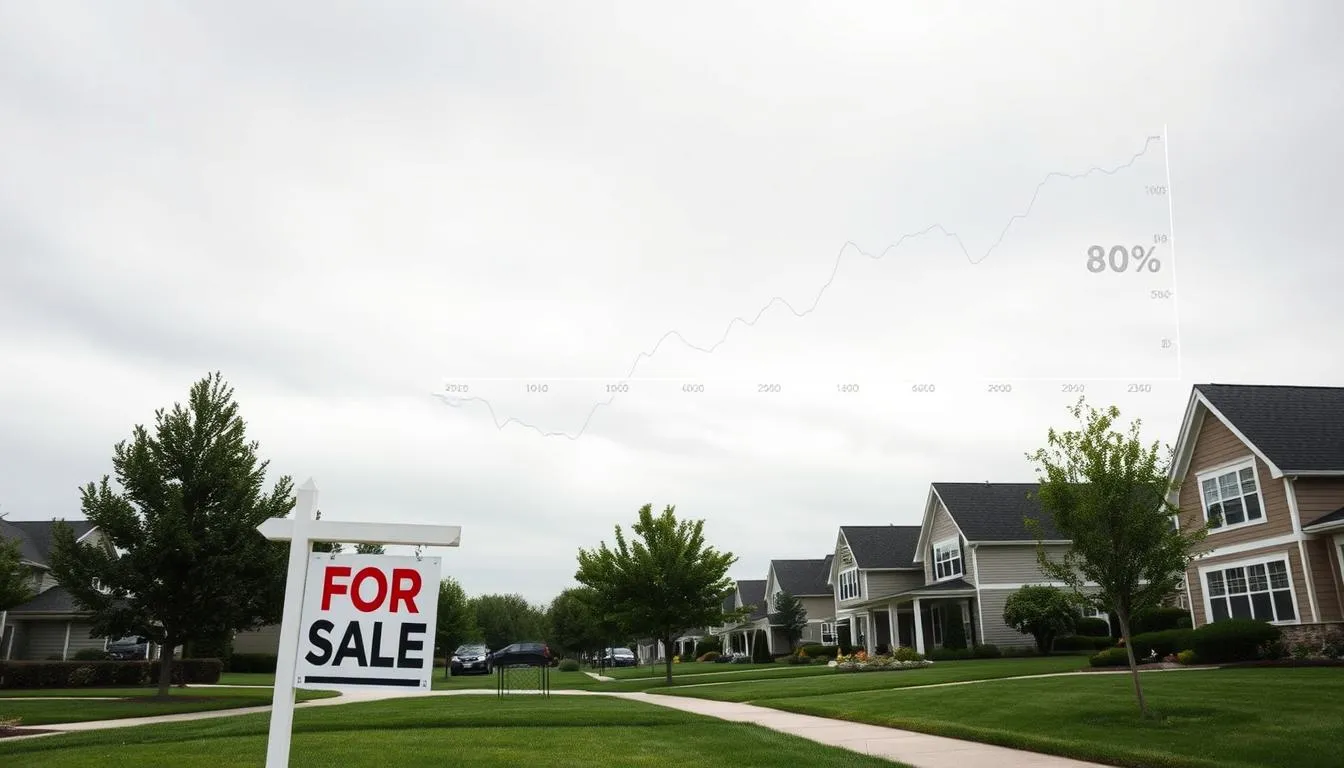Existing-home sales fell 5.4% year over year in June 2024, even as the median sale price hit a record $426,900. That gap tells a clear story: activity is slowing while prices stay high.
This report offers a friendly, data-driven look at what’s happening today and what could change next. Point’s research finds 72% of homeowners now want to move, up from 35% a year earlier, yet many feel stuck.
The core tension is simple: mortgage rates and home prices are both elevated. That combination strains affordability and sidelines buyers, even as sellers and lenders react to the same forces.
We will unpack sales trends, rate dynamics, inventory lock-in, behavioral barriers, policy pressures, and investment angles. Expect clear data, practical insight, and steps homeowners can use in the months ahead.
Key Takeaways
- Sales declined while median prices set new records, signaling imbalance.
- Most homeowners want to move, but many cannot, deepening the standstill.
- High mortgage rates plus high prices squeeze buyers’ options today.
- Timing and financing choices are more complex than in prior years.
- Later sections will translate research and data into practical steps.
Present-day snapshot: where the housing market stands now
Today’s snapshot shows low transaction volumes even as prices keep climbing, a tension that shapes every decision for buyers and sellers.
Existing-home sales have fallen below crisis-era lows
Existing-home sales dropped from about 6.1 million in 2021 to roughly 4.07 million in 2024. That level sits below the 2008 trough of 4.1 million, highlighting how much volume has cooled.
Record-high median home prices are squeezing affordability
The median home sale price hit a record $426,900 in June 2024. When prices sit this high, even small moves in mortgage rates can push monthly payments out of reach for many buyers.

Homeowner sentiment: desire to move up sharply, ability stalled
Point’s research finds 72% of homeowners now want to move, up from 35% a year ago. Yet many plans stalled because owners hold low-rate loans and listings remain scarce.
- Volume fell while prices stayed firm because owners with sub-4% mortgages are reluctant to trade into higher rates.
- Typical spring and summer gains over recent months haven’t reversed the slowdown in home sales.
- The gap between desire and action widened: many planned moves were delayed or canceled over the past year.
Plain-English takeaway: today is a low-activity, high-price environment that leaves many potential movers on the sidelines. For local context and historical perspective, see this analysis of prior price cycles.
Next up: we’ll dig into the drivers behind the slowdown—mortgage costs, pricing power, and the inventory lock-in dynamic.
What’s driving the gridlock: rates, prices, and scarce inventory
After years of record-low financing, a sharp rate shift now shapes both seller choices and buyer budgets. The Federal Reserve raised policy rates by more than 500 basis points over 16 months starting in March 2022.
The average 30-year mortgage climbed from just above 3% in early 2022 to over 7% by year-end. That move reversed the ultra-low era and pushed borrowing costs sharply higher.
Mortgage rates since 2022: the hangover from the pandemic-era boom
Millions of homeowners refinanced into sub-4% loans during the boom. By late 2021 roughly 60% of U.S. owners held those low rates.
Faced with a much higher mortgage rate today, many are reluctant to sell and buy again. That reluctance created a durable supply barrier.

Inventory lock-in: low-rate owners staying put and throttling supply
The lock-in effect is simple: when existing financing is far cheaper than new offers, listings dry up. Scarce resale supply then props up home prices and keeps affordability strained.
Higher borrowing costs plus elevated home prices reduce buyer demand. That combination clogs transaction pipelines across segments and raises timing risk for anyone planning a move.
| Driver | What changed since 2022 | Impact |
|---|---|---|
| Federal Reserve action | Policy rates +500+ bps in 16 months | Mortgage rates spiked; borrowing cost rose |
| Mortgage rate distribution | ~60% had sub-4% loans by 2021 | Many owners stay put; listings fall |
| Prices and affordability | Home prices stayed high despite lower sales | Demand weakens; transactions stall |
| Inflation | Kept interest rates elevated | Slower path to meaningful rate relief |
Bottom line: The pandemic-era refinancing wave plus rapid rate tightening created a structural lock-in. New construction helps, but it cannot fully replace the depth of resale inventory. Small moves in rates or prices can still shift monthly payments enough to change behavior for both buyers and sellers.
Homebuying gridlocked housing market: behavioral barriers and the “lock-in effect”
A clear breakpoint has emerged: owners wait for rates to slip below six percent before acting. That simple threshold reshapes choices, even when other conditions improve.

The sub-6% mortgage rate threshold most owners are waiting for
Point’s research finds that 90% of homeowners who say rates block a move want mortgage rates under 6% to consider buying in the next 6–12 months. That round-number anchor has outsized influence on decisions.
Top reasons moves are delayed or canceled: prices, rates, and too few homes to buy
Among those who planned to buy in the past year, 55% couldn’t complete a move. The top blockers were:
- High home prices — 51% said prices made a new purchase unaffordable.
- Higher mortgage rates — 48% feared ending up with a worse rate.
- Low inventory — 27% couldn’t find suitable listings, limiting access to desired locations or features.
Even small shifts in an interest rate or mortgage rate change monthly payments enough to sway a decision to list or stay. That creates pent-up demand: the longer owners wait, the larger the pool of future buyers when rates ease.
Practical note: lock-in affects move-up and downsize choices alike and may produce bursts of activity if rates fall. Later we’ll look at policy fixes that could ease tax or equity frictions for trapped sellers.
Policy pressure points: capital gains, equity, and proposals to unlock supply
Tax code quirks are an often-overlooked reason long-term owners delay moves and shrink available inventory.
Outdated exclusions allow a $250,000 (single) or $500,000 (married) gain exclusion on a primary residence. That rule hasn’t changed since 1997.
Current research finds about 34% of homeowners already risk exceeding the $250,000 cap and over 10% may exceed $500,000. Projections show more than 56% could exceed $250,000 by 2030 and nearly 70% by 2035.
The stay-put penalty and why it matters
Stay-put penalty describes seniors and long-tenured owners who delay downsizing or relocating because expected taxes at sale reduce their ability to move or cover care costs.
The More Homes on the Market Act
The proposal would double exclusions to $500,000 (individual) and $1 million (married) and index thresholds to inflation. Indexing aligns the code with decades of price gains and limits future distortions.
- More equity homes could list, improving access for first-time and move-up buyers.
- National Association of REALTORS® and member advocates are briefing lawmakers to advance the bill.
- Policy won’t fix all constraints, but it can lower selling costs and free up supply without raising construction costs.
Practical note: homeowners should discuss timing and tax details with a tax professional to understand how any change could affect their plans.
From boom to bottleneck: how we got here and why prices held up
The run-up began when interest and mortgage rates plunged, and millions rushed to lock in cheap financing.
Pandemic-era stimulus and sub-4% loans set the stage
Low interest and broad fiscal support in 2020–2021 drove a fast surge in demand for real estate. Lenders and buyers responded: roughly 60% of homeowners held sub-4% mortgages by late 2021.
That refinancing wave created a powerful incentive to stay put. Cheap mortgage terms gave many owners large monthly savings and rising equity.
Why activity froze but home prices didn’t crash
When the Federal Reserve tightened starting in March 2022, interest rates jumped and the 30-year climbed well above 7% by late 2022. Higher rates pushed borrowing costs up and slowed transactions.
But listings stayed scarce. Owners on low-rate loans rarely sold, so supply tightened and home prices held firm despite fewer sales. Rising equity also cut forced sales and limited downside.
Bottom line: boom-era financing produced a durable lock-in. Whether rates ease or remain sticky will shape how quickly activity and listings return.
What could change next: scenarios, timelines, and investor implications
Future paths split neatly: gentle rate relief could revive sales and new-home activity, while sticky borrowing costs may push owners to renovate and delay moves.
Rate-easing path: thawing sales and new-home activity
If interest rates drift down over the next months, mortgage rates would narrow the payment gap versus owners’ low-rate loans. That shift can make move-up and downsize math work again.
Result: buyer traffic rises, home sales pick up, and builders see higher order flow as new-home starts accelerate.
Sticky-rates scenario: renovations and financing hesitancy
When rates hold, many homeowners favor fixing their current property. Two-thirds plan renovations in the next 12–18 months, with about 39% using cash.
HELOC and cash-out refi use stays muted because mortgage rates remain high. Home equity still funds projects, but financing costs shape choices.
Investment angles: builders, manufactured options, and timing
Homebuilders look attractive if rates ease; many names traded well below October 2024 highs and could rebound with demand.
Manufactured housing offers lower-cost alternatives now, creating opportunities for investors focused on affordability.
| Scenario | Signal to watch | Likely near-term impact |
|---|---|---|
| Rate easing | Fed commentary + lower inflation prints | Higher buyer traffic; rising home sales; builder recovery |
| Sticky rates | Persistent inflation; Fed hawkish tone | More renovations; HELOC caution; slower home sales |
| Policy change | Tax code or incentives from national association realtors member updates | Greater supply from equity homes; eased selling costs |
Takeaway: track Federal Reserve signals, inflation, and association updates. Small moves in rates can unlock pent-up demand; timing and valuation matter for buyers and investors.
Conclusion
The story is simple: high borrowing costs and scarce listings created a squeeze where many homeowners want to move but can’t justify the trade-offs.
Prices stayed firm because supply stayed thin even as transactions cooled. That kept values stable, while volume fell.
Track two things closely: rates and inventory. Knowing your monthly payment threshold, lining up pre-approval, and watching listings will help you choose when to act.
For those staying put, renovations can bridge needs now. Your equity can fund upgrades or become the springboard for a future move.
Stay informed and be ready. When policy shifts or rate relief open a window, you’ll be positioned to move quickly and smartly. Learn more from Point’s movers study here.
FAQ
What does “Navigating the Homebuying gridlocked housing market” mean for buyers and sellers?
It describes today’s tight conditions where high prices, elevated mortgage rates, and limited listings make it hard for homeowners to sell and for buyers to find affordable options. The result is a slowdown in transactions even as home values remain relatively strong.
Why have existing-home sales fallen below crisis-era lows?
Sales dropped because many owners locked in low pandemic-era mortgages are reluctant to trade up, while buyers face higher borrowing costs and weaker affordability. Limited supply and cautious consumer sentiment further suppress transaction volumes.
How can median home prices be record-high when sales are weak?
Prices stayed elevated due to scarce inventory, strong demand in certain markets, and seller expectations. With fewer homes for sale, competition can keep prices high despite fewer overall transactions.
What does homeowner sentiment tell us about moving plans?
Surveys show many owners want to move up but feel unable to because they’d give up low mortgage rates or face higher payments. Desire is strong, but ability to act is stalled, creating the lock-in effect.
How have mortgage rates since 2022 affected the situation?
Rates jumped from pandemic lows to much higher levels, increasing monthly costs for new buyers. That spike reduced buying power and discouraged many homeowners from selling into a higher-rate environment.
What is the inventory lock-in and how does it throttle supply?
Inventory lock-in happens when owners with low-rate loans choose not to sell, shrinking the available stock of homes. Fewer listings mean less choice for buyers and less turnover in the overall housing stock.
What mortgage rate will likely prompt more homeowners to list their homes?
Many analysts and owners cite a sub-6% mortgage rate as a psychological threshold where selling and buying again becomes financially easier for those with very low existing rates.
What are the top reasons people delay or cancel moving plans?
The main reasons are high home prices, elevated mortgage rates, and a shortage of suitable homes to buy. Other factors include job uncertainty, renovation costs, and concerns about home-equity access.
How do capital gains rules contribute to the “stay-put penalty”?
Outdated capital gains exclusions and tax rules can discourage long-time owners from selling because they fear higher tax liabilities or losing valuable tax breaks tied to their primary residence, which reduces turnover.
What is the More Homes on the Market Act and how might it help?
The proposed legislation aims to update tax incentives and remove barriers that keep homeowners from selling. If passed, it could increase listings by easing financial penalties tied to moving and capital gains.
How did pandemic-era policies and low rates lead to today’s bottleneck?
Stimulus, low mortgage rates, and high buyer demand during the pandemic drove strong price gains and high homeownership activity. When rates later rose, those who locked in low rates stayed put, freezing turnover despite strong price levels.
Why didn’t home prices crash even as activity froze?
Tight supply, continued demand in many regions, and limited new construction kept downward price pressure minimal. Investors and buyers with cash or flexible financing also helped support prices.
What would a rate-easing path mean for sales and builders?
Gradual rate declines could revive buyer affordability, encourage owners to list, and boost new-home starts as builders respond to stronger demand. Sales could pick up over months as confidence returns.
What happens if rates remain sticky high for a long time?
If rates stay elevated, many owners will keep renovating rather than moving, HELOC uptake may slow, and buyers might seek alternative financing or lower-cost housing types like manufactured homes.
Where are the best investment angles in this environment?
Opportunities can include homebuilders positioned for a rebound, companies in manufactured housing, and firms offering affordable housing solutions. Timing matters: investors watch rate trends, inventory levels, and consumer sentiment closely.
